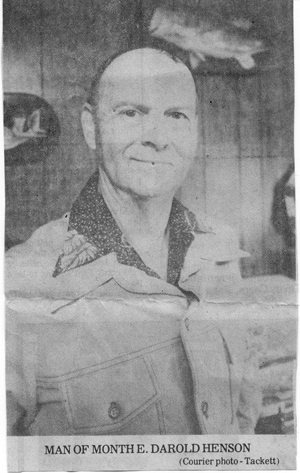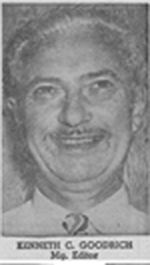In the photo, note the two "lunker" largemouth bass mounted on the wall. I was with him in the early 1970s when he caught the one just above his head, and I had it mounted for him as he has never been interested in collecting trophies.
A successful angler has to be both astute strategist (know where and when to fish) and adept tactician (know the right techniques and how to use them). The mounted fish above his head was taken from a small reservoir of a town in southwestern Illinois. Darold had done his homework in finding a somewhat remote lake with plentiful fish and scant "fishing pressure."

Because it was springtime, he knew the water temperature was
moderate enough that bass would feed near the surface, so he used a
top-water lure. The "go devil" technique requires a long, 9-foot pole,
which is gripped and braced along the inside of the arm.
A lure with a propeller is tied on a heavy line (24-pound test) extending
about six feet from the end of the pole. This lure is dragged back and
forth on the water's surface near the shore, where fish like to feed before
the hot summer sun forces them into deeper, cooler waters.
The larger bass are very protective of their territory, and this lure churns
the water with a loud gurgle that provokes bass into attacking and devouring
the intruder. This method proves very exciting, as hooked fish explode
from the water, jumping and thrashing to shake loose, then diving to break
the line, and jumping and diving again and again until freed or tired and
netted. Often the larger fish do escape, leaving the fisherman with a
most empty, frustrating feeling of loss and defeat; but desire for another
try soon arises.
Fishing, then, can be but is not necessarily a mindless
puttering where the greatest challenge is putting a worm on
a hook and the fun is dozing in the shade of a willow tree on Salt Creek; it
is a sport that can teach the need for thoughtful, skillful perseverance.
Darold has only two mounted fish, symbols of
countless trophy-sized, fresh-water game fish (mainly bass, walleye, and
crappie) caught in his legendary fishing career of approximately 80 years.
|
The Courier article mistakenly says Darold fought in WWII
without injury. In fact, just beyond the beaches of France, he
took shrapnel in the right leg near the knee. He recovered and
continued in the campaign leading to the Battle of the Bulge. In
the bitter winter of that campaign (1944), his feet were nearly frozen,
and he was withdrawn from combat to avoid the threat of amputation.
He received the Purple Heart. He is also eligible for the coveted
Bronze Star, which he has never applied for. I suspect the
misunderstanding between interview subject and interviewer was due to
the customary, modest understatements of the interview subject. He
has told me of his willingness to risk his life in war so that I would
not have to. L.H. |

